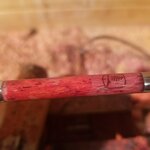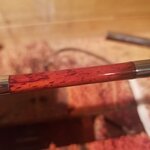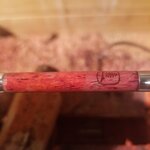In addition to sand-through from bent mandrel, sand through comes about from different reasons:
1. Not thick enough layers of CA. Anyone can apply 10 to 15 layers of thin CA with paper towel and I can apply one layer with medium that is thicker. The point is, It is NOT the number of coats that make a success, it is the thickness and build UP of layers. If you want to know how effective your coats are, use a set of good calipers (metals ones) to measure the diameters Before Appling CA and after applying CA. That will give you the thickness. VERY Thin layers will/can be sanded through in SPOTS.
2. Too much pressure in Sanding will cause the mandrel to give and flex just enough that you will sand more on one side than another.
3. soft woods will sand more on the soft portion between bands of hard grain.
4. Using a stock wood lathe endpoint/live center in the tail stock - in the little cup in the mandrel. The mandrel requires a 60° live center for proper use. The wood lathe live center is made for WOOD, not mandrels. This will cause the tip of the live center to bend a tiny bit and introducer minuscule wobble and sand through on one side.
5. Too Tight on the tail stock with mandrels - Again forcing a minuscule bend in the mandrel - maybe imperceptible to the naked eye but results in sand through in spots.
You mentioned that "you can see the CA but you see flat spots". This is a description that many "new to turning" say. Because the CA can be seen easily - that does not mean that it is everywhere. It has been sanded off in the dull areas. One other item that hides this is if a wax is applied AFTER turning, the shiny wax may hide the sanded spot for a few hours to a few days.



